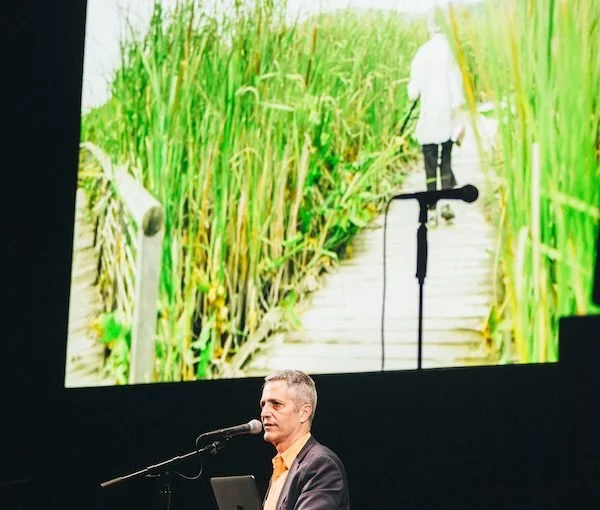At Sam Green's 32 Sounds, audiences use headphones to fully experience the live documentary's sonic world
Narrating live at VIFF, the filmmaker explores the physics and metaphysics of sound
Sam Green at 32 Sounds. Photo by Catalina Kulczar
VIFF presents 32 Sounds on October 5, 7 pm at the Vancouver Playhouse
IN JUNE OF THIS year, Sam Green’s latest doc 32 Sounds finally wrapped a nine-week run at the Film Forum in New York. He jokes that “the bar is very low for a documentary in theatres now,” but it’s a miraculous feat in a time when Barbie and Oppenheimer make headlines for lasting more than few weekends at all.
“You make a film and you never know quite what you’ve made until it’s out in the world and you see how people experience it,” Green tells Stir, calling from New York. “This one I’ve been delighted and somewhat surprised by the level of response. People seem to be very moved by it. And not to read too much into it but I do think we lived through a couple years of pretty intense drama and trauma, and I think that the film, in an indirect way, maybe resonates with a well of feelings that people still have from that time.”
The word resonates is well-chosen, since 32 Sounds is explicitly about the physics and the metaphysics of sound, a spooky phenomenon that we take for granted until a curious filmmaker like Green comes along to make a surprise hit movie about it. Among its many delights is a brief explanation of the mechanism of hearing—already a kind of cockamamie magic when you consider the baroque delicacy of the ear’s moving parts—but 32 Sounds really starts to hum when Green explores the emotional dimensions of the topic. There are sequences in 32 Sounds that reliably trigger an ecstatic response from its audience, whether it’s a playful demonstration of the art of foley, an intense remix of Donna Summer’s “I Feel Love” (courtesy of the film’s soundtrack composer JD Samson), or a haunting scene in which plasma physicist Edgar Choueiri encounters a taped message he made for himself at the age of 11.
“Making this film changed the way I experience the world,” says Green. “Profoundly. In a good way. This is nothing radical, but there’s so much noise that we have to close our ears off most of the time and that becomes a kind of reflexive posture. And sometimes if you can be reminded to open your ears, it can not only be a delightful experience—like John Cage said, ‘All sound can be wonderful’—but for me, it can be a way to remind myself to be in the present and to be in my body.”
Green and his producers have struck on a novel way to reacquaint viewers with both the present and the body. When he arrives in Vancouver for the “live documentary” version of 32 Sounds, which the Oscar-nominated filmmaker narrates in person, patrons will be given headphones to fully encounter the film’s outstanding sonic mise-en-scene. It’s particularly impactful when 32 Sounds switches to binaural sound, an uncanny if under-utilized technology in which microphones are planted inside a replica human head. The effect is something like B-movie king William “The Tingler” Castle turning his attention to the promotion of mindfulness.
“Movies have never been able to crack the code wth binaural technology,” says Green, who travels with 500 sets of headphones for live performances of 32 Sounds. “Dolby Atmos is as close as it gets but it’s not quite real in terms of spatial proximity. You can’t get Dolby Atmos to feel like somebody’s shaking a box of matches right next to your ear, which is what binaural sound can do.” Green is abetted in the project by sound designer Mark Mangini, who previously brought his mastery of “an inexact science” to features including Dune and Mad Max: Fury Road. “If you can go from Dune to a tiny-ass indie film about sound, that’s great,” remarks Green, with a hint of reverence, “He was a real guru. He not only did the sound design but I had about a two year conversation with him about sound.”
In the end, 32 Sounds charms because it actually feels like a conversation about sound, largely built on thoughtful and often esoteric tangents, and aware of its own circuitous process.
“If I was making a fiction version it would be far less interesting because the world, and randomness, and chance, and serendipity is much more interesting than anything I can think of,” offers Green. “There’s a lot of very cliched language around that stuff, like, ‘the sculptor who says the sculpture just emerges from the rock,’ and in the past I’ve kind of pooh-pooh’d that kind of thing, but this is the first film I’ve made where it’s really true. I did not know where I was going and I had a faith that it would get somewhere, and it did, and it was not necessarily where I thought it would go.”
It would be tacky to reveal where 32 Sounds goes, or the emotional payload of its final third, but it would also be remiss to not mention how it all begins, with Green stumbling across the name of Annea Lockwood, an avant-garde sound artist and notable contemporary of John Cage. He was sufficiently intrigued to contact the New Zealand composer. Three years later she’s the humble eminence grise who inhabits and lends a philosophical perspective to the film. If her name is unfamiliar, it’s because Lockwood shows zero interest in celebrity, treating sound as her church.
“Not only that,” adds the filmmaker, with a laugh, “but she’s just a real ray of sunshine. There’s not a lot of old avant garde artists in their 80s that are still delightful. Many of them are bitter and angry and weird, so I appreciate her.” Hear, hear!














